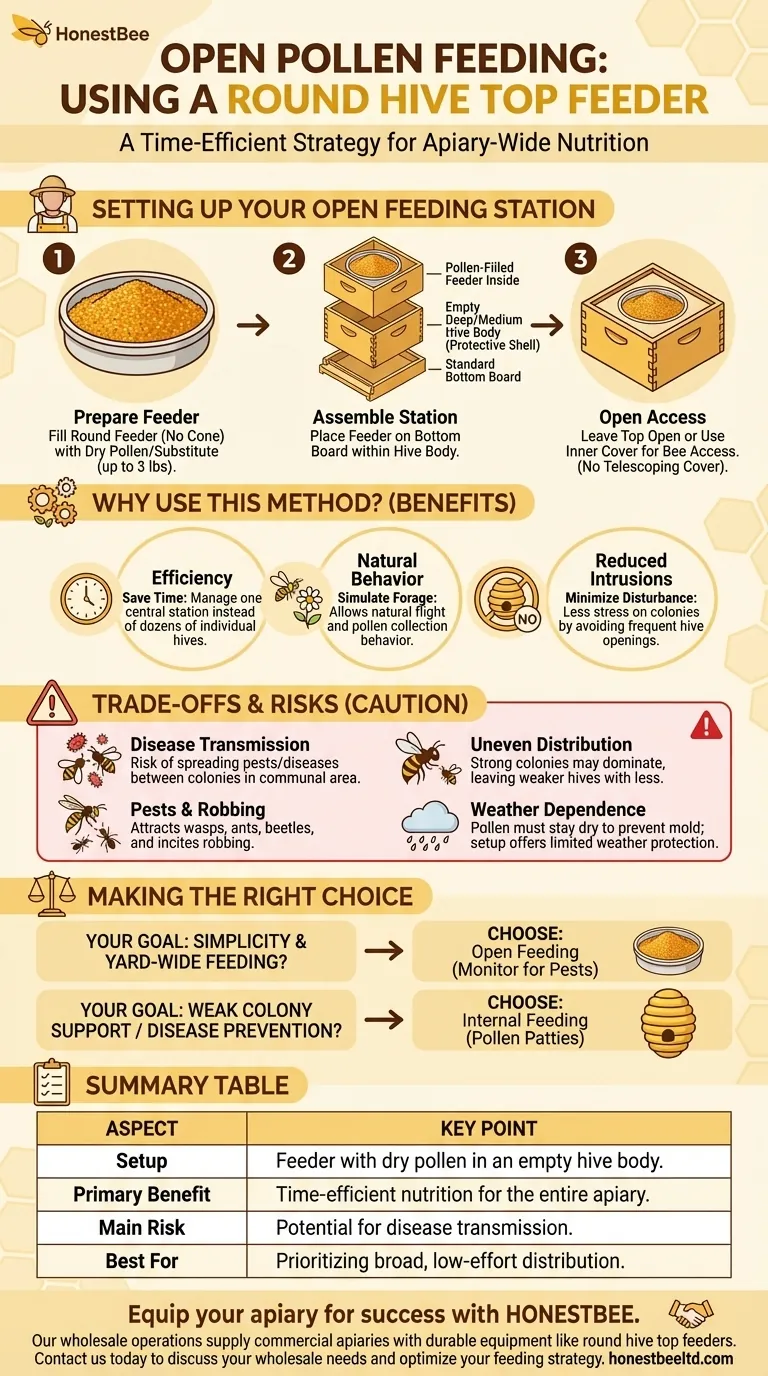To use a round hive top feeder for open pollen feeding, the feeder is filled with dry pollen and placed inside an empty hive body within the bee yard. This setup creates a protected, communal feeding station accessible to all of your colonies, simulating a large natural pollen source.
Open feeding is a time-efficient strategy for providing supplemental nutrition to an entire apiary. However, its core trade-off is sacrificing colony-specific control for broad, low-effort distribution, which introduces risks like disease transmission and resource competition.

Setting Up Your Open Pollen Feeder
The goal is to create a station that protects the pollen from the elements while allowing easy access for your bees.
Preparing the Feeder
The round hive top feeder is a versatile tool. For this purpose, you will use it for dry feed, not syrup.
Do not use the cone insert that is typically used for liquid feed. Simply fill the main reservoir with up to three pounds of dry pollen or a pollen substitute.
Assembling the Feeding Station
Place a standard bottom board in a suitable location in your bee yard—ideally somewhere central, sunny, and sheltered from strong winds.
Place an empty deep or medium hive body on top of the bottom board. This box will act as a protective shell for your feeder.
Set the pollen-filled round feeder directly on the bottom board inside the empty hive body.
Leave the top of the hive station open to the air or use an inner cover to provide a landing area and entrance. Do not use a telescoping outer cover, as this will prevent the bees from accessing the pollen.
Why Use This Method? The Principles of Open Feeding
Open feeding is a specific strategy with distinct advantages over feeding each hive individually.
Efficiency for the Beekeeper
This method is exceptionally time-efficient. Rather than opening dozens of hives to place individual pollen patties, you manage a single feeding station for the entire apiary.
Simulating Natural Forage
Open feeding allows bees to exhibit natural foraging behavior. They will fly to the source, collect the pollen, and return to their hive, just as they would with a field of flowers.
Reducing Hive Intrusions
By avoiding the need to open each colony, you minimize disturbance and stress on your bees. This maintains the hive's internal environment and reduces the risk of angering the colonies.
Understanding the Trade-offs and Risks
While convenient, open feeding is not without significant drawbacks that require careful consideration.
Potential for Disease Transmission
A communal feeding station can become a vector for transmitting pests and pathogens, like mites or foulbrood, between colonies. Healthy bees and sick bees will intermingle at the feeder.
Uneven Resource Distribution
Stronger, more populous colonies will likely dominate the feeder. They can outcompete and bully weaker colonies, meaning the hives that need the nutrition most may get the least.
Attracting Pests and Robber Bees
An open food source is a powerful attractant. It can draw in wasps, ants, and small hive beetles. It can also incite robbing behavior from neighboring apiaries, placing your colonies at risk.
Dependence on Weather
The pollen must be kept dry to prevent mold and spoilage. While placing the feeder in an empty hive body offers good protection from rain, it is not foolproof in driving wind and storms.
Making the Right Choice for Your Goal
Your feeding strategy should align directly with your beekeeping objectives.
- If your primary focus is simplicity and feeding the entire yard with minimal effort: Open feeding with a round top feeder in a dedicated hive is an effective method, but you must monitor it for pests.
- If your primary focus is supporting a specific weak colony or preventing disease spread: Internal feeding with pollen patties placed directly inside the hive is the more targeted and safer approach.
Understanding these trade-offs empowers you to provide the best possible support for your bees' nutritional needs.
Summary Table:
| Aspect | Key Point |
|---|---|
| Setup | Feeder with dry pollen placed in an empty hive body. |
| Primary Benefit | Time-efficient nutrition for the entire apiary. |
| Main Risk | Potential for disease transmission between colonies. |
| Best For | Beekeepers prioritizing broad, low-effort distribution. |
Equip your apiary for success with HONESTBEE. Our wholesale-focused operations supply commercial apiaries and beekeeping equipment distributors with durable, reliable supplies—like round hive top feeders—designed for efficient, large-scale management. Ensure your bees get the nutrition they need with the right equipment. Contact our team today to discuss your wholesale needs and optimize your feeding strategy.
Visual Guide

Related Products
- HONESTBEE Professional Hive Top Bee Feeder Feeding Solution
- HONESTBEE Round Hive Top Bee Feeder for Syrup
- Professional Hive Top Bee Feeder for Beekeeping
- Rapid Bee Feeder White Plastic 2L Round Top Feeder for 8 or 10-Frame Bee Hives
- Professional Hive Front Entrance Bee Feeder
People Also Ask
- What are the advantages of hive top feeders? Maximize Feeding Efficiency for Your Apiary
- What features make top feeders a reliable choice for beekeepers? A Guide to Safe, Efficient Hive Nutrition
- How do I keep bees from drowning in my top feeder? Ensure Safe Feeding for Your Hive
- Do I need an inner cover with a hive top feeder? Optimize Your Hive Setup for Healthy Bees
- What should be done with feeders and equipment after feeding bees? Essential Steps for Apiary Health



















